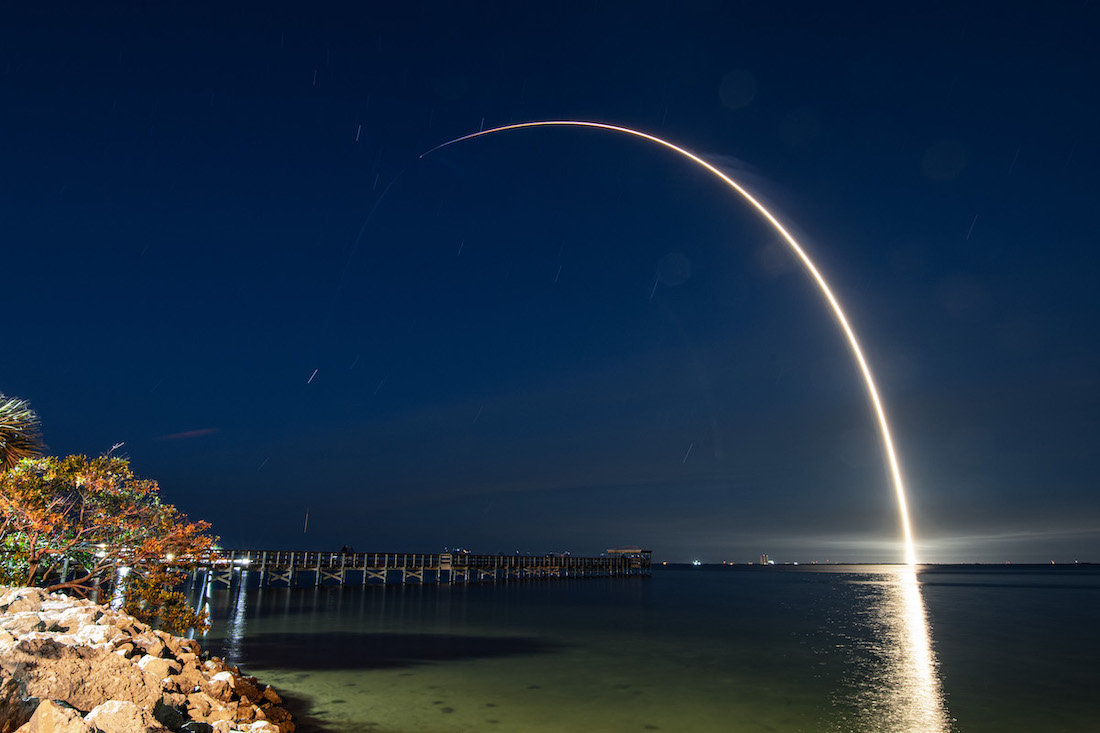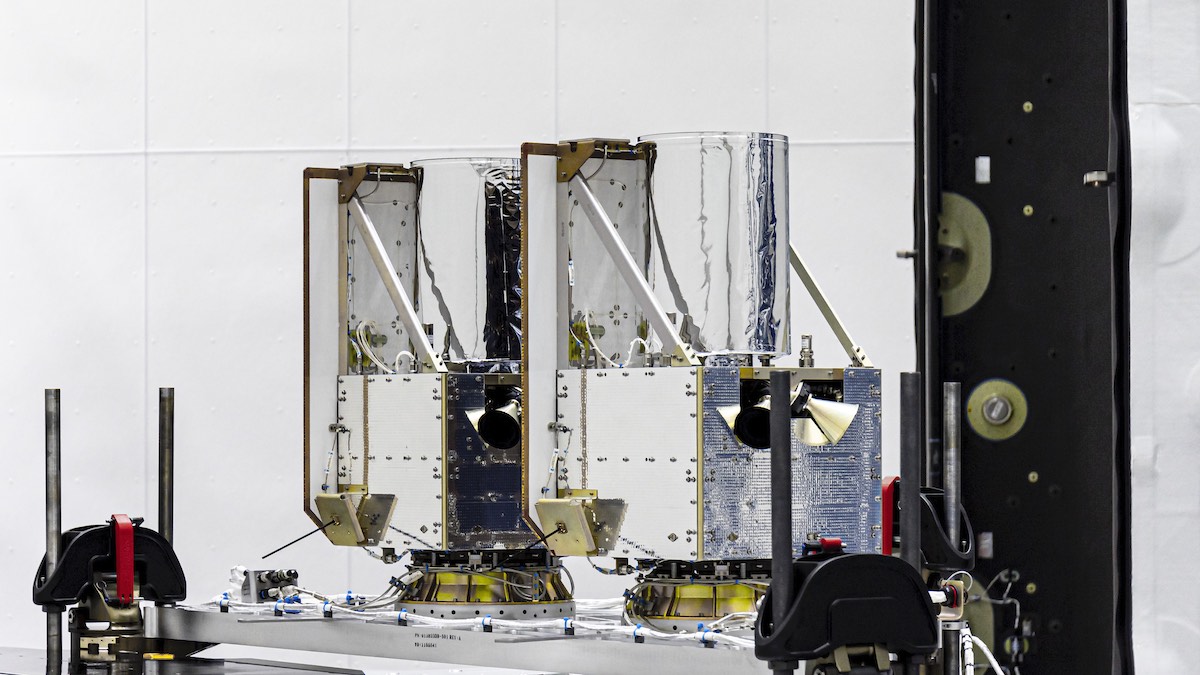
SpaceX set a new record Thursday for the most missions by the company’s Falcon rocket family in a year, successfully sending a cargo of 48 Starlink internet satellites and two BlackSky optical Earth-imaging spacecraft into orbit from Cape Canaveral.
The two-stage, 229-foot-tall (70-meter) Falcon 9 rocket lifted off from pad 40 at Cape Canaveral Space Force Station at exactly 6:12 p.m. EST (2312 GMT).
With a glow of orange, followed seconds later by a ground-shaking rumble, the Falcon 9 cleared the seaside launch complex and arced downrange northeast over the Atlantic Ocean. Nine Merlin 1D main engines, burning a mix of kerosene and liquid oxygen propellants, powered the rocket into a clear late autumn sky with 1.7 million pounds of thrust.
The first stage, itself 15 stories in height, shut down its nine engines and detached from the Falcon 9’s upper stage more than two-and-a-half minutes after liftoff. That left the upper stage’s Merlin engine to drive the 50 satellite payloads into a parking orbit less than 10 minutes into the mission.
Meanwhile, the Falcon 9’s reusable booster stage coasted to the apex of its ballistic trajectory, then plunged back into the atmosphere at roughly 5,000 mph (8,000 kilometers per hour).
Here’s a replay of SpaceX’s Falcon 9 rocket departing Cape Canaveral at 6:12pm EST (2312 GMT) with 48 Starlink internet satellites and two BlackSky remote sensing microsats. https://t.co/GNgwv4wfvn pic.twitter.com/hWuufU3PH7
— Spaceflight Now (@SpaceflightNow) December 2, 2021
Braking maneuvers using three, then one, of the first stage’s engines slowed the booster for a pinpoint touchdown on SpaceX’s football field-sized drone ship “A Shortfall of Gravitas” positioned in the Atlantic Ocean east of Charleston, South Carolina.
The first stage, designated B1060 in SpaceX’s fleet, returned to Earth after its ninth trip to space and back. The drone ship will return to Florida’s Space Coast with the booster, which SpaceX will inspect and refurbish for a future flight assignment.
A SpaceX recovery ship was also on station downrange in the Atlantic Ocean to retrieve the two halves of the Falcon 9 rocket’s payload fairing, which the company also reuses. The fairing shells on Thursday night’s mission were new.
The Falcon 9 rocket’s upper stage coasted halfway around the world, flying over Europe, the Middle East, and the Indian Ocean before briefly reigniting its engine off the coast of Australia about an hour into the mission.
The second upper stage engine firing circularized the rocket’s orbit at about 270 miles (440 kilometers), according to altitude data displayed on SpaceX’s live launch webcast.
That set the stage for the final phase of the mission, the satellite deployment sequence.
First, the rocket cast off the two 121-pound (55-kilogram) BlackSky satellites fastened to the top of the stack of Starlink satellites. The twin satellites, each hosting an optical imaging telescope for Earth observations, separated from the rocket at T+plus 63 minutes and T+plus 67 minutes.
The upper stage then released the cluster of Starlink internet stations at 7:41 p.m. EST (0041 GMT), or 89 minutes after liftoff, while flying outside the range of SpaceX ground stations. SpaceX confirmed the deployment of the Starlink satellites a few minutes later, when the rocket flew over a tracking site at the company’s Starbase complex in South Texas.
SpaceX’s Falcon 9 booster has landed on the drone ship “A Shortfall of Gravitas” in the Atlantic Ocean.
This was the ninth launch and landing for this rocket — designated B1060 — in nearly 18 months of service.
Live coverage: https://t.co/GNgwv4wfvn pic.twitter.com/XFjqfNz0C4
— Spaceflight Now (@SpaceflightNow) December 2, 2021
The on-target satellite deployments punctuated SpaceX’s 27th Falcon 9 launch of the year, exceeding a previous record for Falcon 9 launch activity set last year with 26 missions.
SpaceX has three more Falcon 9 launches scheduled from Florida’s Space Coast before the end of December.
Next up is the launch of NASA’s Imaging X-ray Polarimetry Explorer, or IXPE mission from pad 39A at Kennedy Space Center on Dec. 9. The IXPE spacecraft carries three X-ray telescopes that will probe conditions around black holes and neutron stars, some of the most extreme environments in the universe.
Another Falcon 9 rocket is scheduled to blast off from Cape Canaveral Space Force Station on Dec. 18 with the Turksat 5B geostationary communications satellite. A SpaceX cargo mission to the International Space Station is slated to take off Dec. 21 from Kennedy Space Center.
SpaceX could launch one more Falcon 9 rocket mission from Vandenberg Space Force Base in California later this month. But there’s no firm launch date for that mission, which will carry another batch of Starlink satellites into orbit.

With the launch of 48 more Starlink satellites Thursday night, SpaceX has delivered 1,892 spacecraft to orbit for its privately-funded global broadband network. That figure does not include failed satellites and other Starlink craft SpaceX has deorbited.
Thursday night’s mission, named Starlink Group 4-3, was SpaceX’s 32nd Falcon 9 launch since May 2019 primarily dedicated to hauling Starlink satellites to orbit.
Most of the Starlink satellites launched so far have deployed into a 341-mile-high (550-kilometer), 53-degree inclination orbit, the first of five orbital shells SpaceX plans to complete full deployment of the Starlink network. SpaceX finished launching satellites in that shell with a series of Starlink flights from Cape Canaveral from May 2019 through May of this year.
Since May, SpaceX has rushed to complete development of new inter-satellite laser terminals to put on all future Starlink satellites. The laser crosslinks, which have been tested on a handful of Starlink satellites on prior launches, will reduce the reliance of SpaceX’s internet network on ground stations.
The ground stations are expensive to deploy, and come with geographical — and sometimes political — constraints on where they can be positioned. Laser links will allow the Starlink satellites to pass internet traffic from spacecraft to spacecraft around the world, without needing to relay the signals to a ground station connected to a terrestrial network.
SpaceX is currently providing interim internet services through the Starlink satellites to consumers who have signed up for a beta testing program.
In September, SpaceX launched the first batch of 51 Starlink satellites into a 70-degree inclination orbit on a Falcon 9 rocket from Vandenberg Space Force Base. That orbital shell will eventually contain 720 satellites at an altitude of 354 miles (570 kilometers).
Aside from the 53-degree and 70-degree orbital shells, SpaceX’s other Starlink layers will include 1,584 satellites at 335 miles (540 kilometers) and an inclination of 53.2 degrees, and 520 satellites spread into two shells at 348 miles (560 kilometers) and an inclination of 97.6 degrees.
Video downlinked from SpaceX’s Falcon 9 rocket over South Texas showed 48 Starlink internet satellites flying free of the upper stage, completing tonight’s successful launch.
This brings the total number of Starlink craft launched to 1,892.https://t.co/GNgwv4wfvn pic.twitter.com/bvlK7mKhz3
— Spaceflight Now (@SpaceflightNow) December 3, 2021
The mission Thursday night was the second Starlink flight to target the 53.2-degree inclination orbit, slightly offset from the 53-degree inclination planes populated during the first phase of the Starlink network deployment. The previous Starlink launch Nov. 13 was the first to go into the 53.2-degree orbital plane.
SpaceX has regulatory approval from the Federal Communications Commission for approximately 12,000 Starlink satellites. The company’s initial focus is on launching 4,400 satellites on a series of Falcon 9 rocket flights. SpaceX’s next-generation launcher, a giant rocket called the Starship that has not yet reached orbit, may eventually be tasked with launching hundreds of next-generation Starlink satellites on a single mission.
The two remote sensing microsatellites that hitched a ride to space on the Falcon 9 rocket Thursday night join eight others in BlackSky’s active constellation.
Two BlackSky satellites launched Nov. 17 on a Rocket Lab mission from New Zealand, and Rocket Lab plans another launch next week carrying two more BlackSky payloads.
Expanding the constellation “will enhance the company’s geospatial capacity for data while increasing revisit rates for customers,” BlackSky said in a statement.
The surge of launches with BlackSky satellites will double the size of the company’s fleet from six to 12 spacecraft over a period of less than three weeks.
Another two BlackSky satellites are booked for launch on a Rocket Lab mission in early 2022. The remote sensing company has ordered additional spacecraft from its manufacturer, LeoStella, based in Tukwila, Washington, a suburb of Seattle.
LeoStella is a joint venture between BlackSky and Thales Alenia Space, a major European satellite manufacturer.
BlackSky, with offices in Seattle and Herndon, Virginia, is deploying a fleet of small remote sensing satellites to provide high-resolution Earth imagery to commercial and government clients. The company expects to reach a fleet size of 30 satellites within a few years.
One big customer for BlackSky is the U.S. military and intelligence agencies. BlackSky has agreements to sell commercial imagery to NASA, the National Reconnaissance Office and the National Geospatial-Intelligence Agency.
BlackSky says the commercial market for its services include customers in transportation, infrastructure, construction, and supply chain management.

Each of the current generation of BlackSky Global spacecraft can capture up to 1,000 color images per day, with a resolution of about 3 feet (1 meter). In the future, BlackSky will deploy a third generation of BlackSky satellites with sharper resolution level of about 20 inches, or 50 centimeters.
The company uses artificial intelligence and machine learning algorithms to process and analyze imagery beamed back to Earth from BlackSky satellites. The algorithms and detect and identify objects in the images without humans in the loop, according to BlackSky.
SpaceX provides relatively low-cost rides to orbit to external customers by selling extra capacity on its Starlink missions. The launch company also launches dedicated rideshare flights, called Transporter missions, with dozens of small satellites from a range of U.S. and international customers.
Spaceflight, a Seattle-based company, managed the rideshare launch service for BlackSky, which is a return customer with SpaceX. Three BlackSky satellites launched on previous Falcon 9 missions, including two on a Starlink launch in August 2020.
According to SpaceX’s website, the company charges $1 million to launch a 440-pound (200-kilogram) satellite on a rideshare mission. That’s significantly lower than any other launch provider, including small satellite launchers like Rocket Lab’s Electron.
But Rocket Lab and other smallsat launch companies can satellites into orbit on dedicated rides, giving operators more flexibility to choose their altitude and inclination.
Email the author.
Follow Stephen Clark on Twitter: @StephenClark1.
from Spaceflight Now https://ift.tt/3ohewWn
via World Space Info







0 comments:
Post a Comment